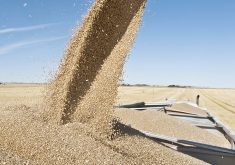Analyst says a looming solar cycle will bring volatile weather and disrupt markets, but Environment Canada disagrees
Hold onto your hats because the Earth is about to enter a weather cycle that will rock grain markets for years to come, says an analyst.
Shawn Hackett, owner of Hackett Financial Advisors, said the Earth is entering into the first trough of a grand solar minimum phase of the sun’s sunspot cycle.
He said every 200 years or so the sun’s magnetic fields cancel each other out and sunspots are unable to form the way they usually would.
That is going to lead to extreme weather volatility and reduced yields around the globe.
Read Also

India slaps 30 per cent import duty on yellow peas
India has imposed a 30 per cent duty on yellow pea imports with a bill of lading date on or after Nov. 1, 2025.
Hackett said 2019 will be the last year of decent growing conditions and then it is going to turn ugly … real ugly.
“We expect the next three years to be very, very disruptive and expect food prices to absolutely go nuts to the upside,” he said.
Environment Canada has a different take on the solar cycle. It says the radiant energy from the sun fluctuates by a small amount over the 11-year solar cycle.
“These fluctuations can explain global temperature variations of up to approximately 0.1 C between the strongest and weakest parts of the cycle,” spokesperson Veronica Petro said in an e-mail.
“At present, there is very low confidence concerning future solar forcing irradiance estimates, including changes to the duration of the solar minimum.”
Even if there is a decrease in solar activity it would have a much smaller effect on global temperatures than the projected increases in greenhouse gases, she said.
But Hackett expects a major cooling pattern when the weather pattern transitions from El Nino to La Nina during the trough of a grand solar minimum. And that will likely occur during the 2020 to 2022 period.

“This kind of weird, strange, kind of odd weather we’ve been seeing in the last 12 to 18 months is just the beginning of what’s going to become a far more severe pattern over time,” he said.
The usual west-to-east flow of the northern and southern jet streams will switch to a more north-to-south flow. The recent polar vortex is one example of what will happen far more frequently.
There will be more cosmic rays reaching the Earth’s atmosphere and that is going to result in increased cloud cover and more earthquakes and volcanic eruptions, he said.
All of those changes will result in reduced U.S. grain output along the lines of 2012 and 2006, according to Hackett.
“I don’t want to sound like there’s no hope for the future with this new weather pattern,” he said.
“I’m not saying that at all. In fact, there’s tremendous opportunity because markets will start moving like crazy.”
Hackett said that is far more preferable than today’s corn market, where price volatility is at a 50-year low.
He said farmers will do better in the next five years than they have in the past five as long as they are prepared for what’s coming.
Hackett advises his clients to store as much grain as possible and wait for prices to move higher.
“You cannot miss this,” he said.
They should buy futures and options that keep them “open to the upside” in grain markets rather than selling production two or three years out at today’s prices.
He is also advising clients to start growing shorter-season varieties because the growing season is going to be truncated by late-spring frosts and early fall frosts.
















